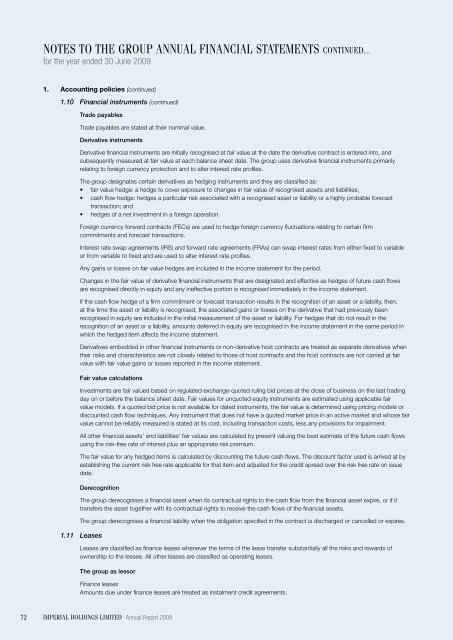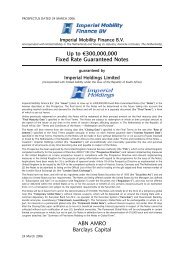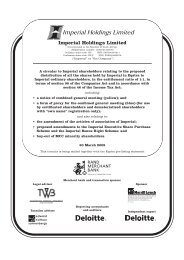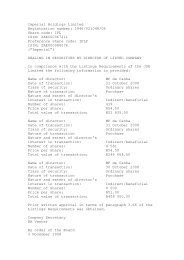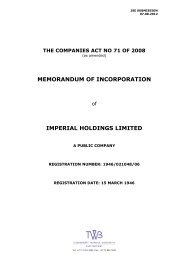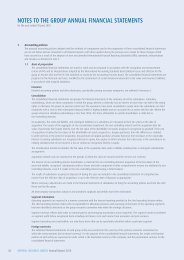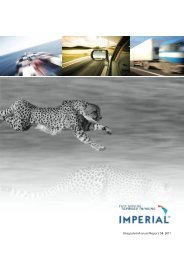4.0 - Imperial
4.0 - Imperial
4.0 - Imperial
Create successful ePaper yourself
Turn your PDF publications into a flip-book with our unique Google optimized e-Paper software.
Notes to the group annual financial statements continued...<br />
for the year ended 30 June 2009<br />
1. Accounting policies (continued)<br />
1.10 Financial instruments (continued)<br />
Trade payables<br />
Trade payables are stated at their nominal value.<br />
Derivative instruments<br />
Derivative financial instruments are initially recognised at fair value at the date the derivative contract is entered into, and<br />
subsequently measured at fair value at each balance sheet date. The group uses derivative financial instruments primarily<br />
relating to foreign currency protection and to alter interest rate profiles.<br />
The group designates certain derivatives as hedging instruments and they are classified as:<br />
• fair value hedge: a hedge to cover exposure to changes in fair value of recognised assets and liabilities;<br />
• cash flow hedge: hedges a particular risk associated with a recognised asset or liability or a highly probable forecast<br />
transaction; and<br />
• hedges of a net investment in a foreign operation.<br />
Foreign currency forward contracts (FECs) are used to hedge foreign currency fluctuations relating to certain firm<br />
commitments and forecast transactions.<br />
Interest rate swap agreements (IRS) and forward rate agreements (FRAs) can swap interest rates from either fixed to variable<br />
or from variable to fixed and are used to alter interest rate profiles.<br />
Any gains or losses on fair value hedges are included in the income statement for the period.<br />
Changes in the fair value of derivative financial instruments that are designated and effective as hedges of future cash flows<br />
are recognised directly in equity and any ineffective portion is recognised immediately in the income statement.<br />
If the cash flow hedge of a firm commitment or forecast transaction results in the recognition of an asset or a liability, then,<br />
at the time the asset or liability is recognised, the associated gains or losses on the derivative that had previously been<br />
recognised in equity are included in the initial measurement of the asset or liability. For hedges that do not result in the<br />
recognition of an asset or a liability, amounts deferred in equity are recognised in the income statement in the same period in<br />
which the hedged item affects the income statement.<br />
Derivatives embedded in other financial instruments or non-derivative host contracts are treated as separate derivatives when<br />
their risks and characteristics are not closely related to those of host contracts and the host contracts are not carried at fair<br />
value with fair value gains or losses reported in the income statement.<br />
Fair value calculations<br />
Investments are fair valued based on regulated exchange-quoted ruling bid prices at the close of business on the last trading<br />
day on or before the balance sheet date. Fair values for unquoted equity instruments are estimated using applicable fair<br />
value models. If a quoted bid price is not available for dated instruments, the fair value is determined using pricing models or<br />
discounted cash flow techniques. Any instrument that does not have a quoted market price in an active market and whose fair<br />
value cannot be reliably measured is stated at its cost, including transaction costs, less any provisions for impairment.<br />
All other financial assets’ and liabilities’ fair values are calculated by present valuing the best estimate of the future cash flows<br />
using the risk-free rate of interest plus an appropriate risk premium.<br />
The fair value for any hedged items is calculated by discounting the future cash flows. The discount factor used is arrived at by<br />
establishing the current risk free rate applicable for that item and adjusted for the credit spread over the risk free rate on issue<br />
date.<br />
Derecognition<br />
The group derecognises a financial asset when its contractual rights to the cash flow from the financial asset expire, or if it<br />
transfers the asset together with its contractual rights to receive the cash flows of the financial assets.<br />
The group derecognises a financial liability when the obligation specified in the contract is discharged or cancelled or expires.<br />
1.11 Leases<br />
Leases are classified as finance leases whenever the terms of the lease transfer substantially all the risks and rewards of<br />
ownership to the lessee. All other leases are classified as operating leases.<br />
The group as lessor<br />
Finance leases<br />
Amounts due under finance leases are treated as instalment credit agreements.<br />
72<br />
<strong>Imperial</strong> holdings limited Annual Report 2009


